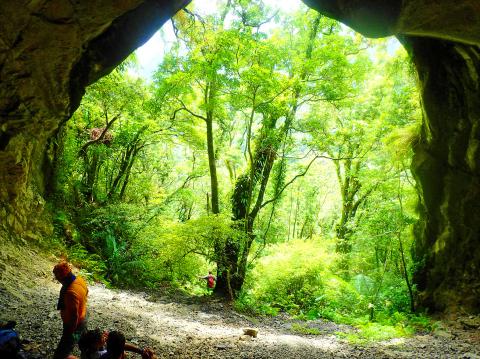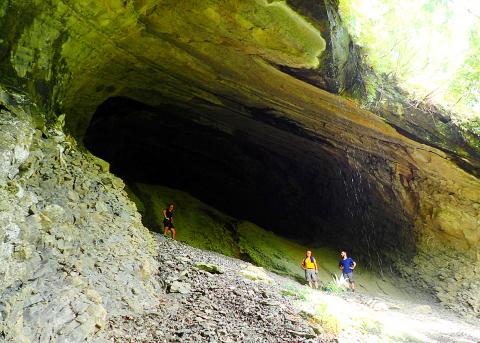Huangdidian (皇帝殿) has been one of the classic hikes of New Taipei City area for decades now. Even when I first hiked there back in the mid-90s, it couldn’t by any stretch of the imagination be described as “off the beaten track.” I got to enjoy it a couple of times before the local authorities turned most of the trails leading up to the ridge into wide paths of stone steps, which are great for families in dry weather, but treacherously slippery when wet.
Once those horrible steps are left behind, the ridge trails are so much fun that for many years I was never able to tear myself away from the main area and explore further. For those unfortunates who didn’t know Huangdidian over a decade ago, most ledges were a lot narrower. In an attempt to make the hike less “risky,” the rock has been chiseled away to make the ledge wider in many places. The footholds cut into the rockfaces are also much bigger than before. But even today, the knife-edge ridges are still a fun adrenaline rush.
Most first-timers to Huangdidian are happy sticking to the popular tourist route, which connects the West Peak (東峰) and East Peak (東峰). On subsequent visits, try leaving the weekend crowds behind and explore the less popular trails a little further east along the ridge, (they haven’t yet been “improved,”) and are still fun and challenging.

Photo: Richard Saunders
Perhaps the most compelling reason to go this way, though, is Huangdidian bat cave (皇帝殿蝙蝠洞), the largest cave mouth in the Taipei and New Taipei City area. It’s a short but tough side trip from the usual circuit, and certainly not for inexperienced hikers, nor one to be attempted alone.
The quickest way to the cave is to take the wide stone steps from the car park at Siaocukeng (小粗坑) trailhead and go up to the East Peak — do not take the set on the left, which go up to Tianwang cave temple (天王廟)and the West Peak. The steps wind up through the woods, and eventually peter out just a few meters below the summit of the ridge. Here, look out for a rough, indistinct dirt trail branching off to the right, which soon climbs very steeply.
Keep straight on at a junction, and the trail soon follows an overgrown knife-edge ridge of rock. Shortly, a tin sign pointing straight down the wooded precipice to the right (with fixed ropes the whole way) shows the way down to the bat cave.

Photo: Richard Saunders
At the bottom swing right, following a natural, horizontal crack in the cliff face. There’s no solid ground at all in places, the precipice falling away below, but the exposed tree roots are strong enough to take the feet of an occasional hiking group. Finally, scramble up a very steep scree of loose rocks to the cave above — take care while climbing not to send any rocks hurtling down on others below.
CAVING IN
It’s only from inside that the cave’s size can be appreciated, but don’t hang around too long — the cave roof is unstable and there’s a risk of rock falls. And yes, there are a few bats inside.

Photo: Richard Saunders
Head back to Huangdidian East Peak (563m), which offers a fantastic view. Follow the base of the bare blade of sandstone at its summit, and beyond it the trail soon descends along the sharp spine of rock. This short stretch after the East Peak is one of the finest moments along the entire ridge, with inspiring views in clear weather.
To get down you have a choice of two routes. Either retrace your steps back to the East Peak and follow the popular route along the knife-edges and down one of three stone-step paths back to Siaocukeng car park, or (for a more interesting, much less crowded route) continue east, past the pointed little finger of rock called Siaobajian (小霸尖), then descend, via another stone step path, to little Yongding village (永定) on Provincial Route 106, the road connecting Muzha to Ruifang.
Turn left through the village to a bus stop for bus 795, which goes to Muzha MRT station. Next to it a small shop sells ice-cold drinks — a very welcome end to a strenuous four to five hour hike.
IF YOU GO
◆ Huangdidian is best reached by taking the ominously-numbered bus 666 from Jingmei MRT station, which leaves from near exit 2. From the MRT exit, walk down the street towards the wooded hill for another hundred meters. Cross the road and beside a small park is the bus stop.
◆ To complicate matters, bus 666 has three routes, only one of which passes close to the trailhead of Huangdidian, so check times in advance and aim to take one of the infrequent buses that stop at Huangdidian bus stop (皇帝殿站). Otherwise take any bus 666 service, get off at Shiding bus stop (石碇站) and follow the road (Provincial Route 106) ahead, beside the stream (soon crossing it) for about 1.5km to Huangdidian bus stop.
◆ Now take the lane on the left beside the bus stop, cross the stream and pass a temple. At the junction follow either branch (the two roads rejoin a little further up) for another kilometer to the car park and trailhead at Siaocukeng.

This month the government ordered a one-year block of Xiaohongshu (小紅書) or Rednote, a Chinese social media platform with more than 3 million users in Taiwan. The government pointed to widespread fraud activity on the platform, along with cybersecurity failures. Officials said that they had reached out to the company and asked it to change. However, they received no response. The pro-China parties, the Chinese Nationalist Party (KMT) and Taiwan People’s Party (TPP), immediately swung into action, denouncing the ban as an attack on free speech. This “free speech” claim was then echoed by the People’s Republic of China (PRC),

Exceptions to the rule are sometimes revealing. For a brief few years, there was an emerging ideological split between the Democratic Progressive Party (DPP) and Chinese Nationalist Party (KMT) that appeared to be pushing the DPP in a direction that would be considered more liberal, and the KMT more conservative. In the previous column, “The KMT-DPP’s bureaucrat-led developmental state” (Dec. 11, page 12), we examined how Taiwan’s democratic system developed, and how both the two main parties largely accepted a similar consensus on how Taiwan should be run domestically and did not split along the left-right lines more familiar in

Many people in Taiwan first learned about universal basic income (UBI) — the idea that the government should provide regular, no-strings-attached payments to each citizen — in 2019. While seeking the Democratic nomination for the 2020 US presidential election, Andrew Yang, a politician of Taiwanese descent, said that, if elected, he’d institute a UBI of US$1,000 per month to “get the economic boot off of people’s throats, allowing them to lift their heads up, breathe, and get excited for the future.” His campaign petered out, but the concept of UBI hasn’t gone away. Throughout the industrialized world, there are fears that

The Democratic Progressive Party (DPP) controlled Executive Yuan (often called the Cabinet) finally fired back at the opposition-controlled Legislative Yuan in their ongoing struggle for control. The opposition Chinese Nationalist Party (KMT) and Taiwan People’s Party (TPP) acted surprised and outraged, but they should have seen it coming. Taiwan is now in a full-blown constitutional crisis. There are still peaceful ways out of this conflict, but with the KMT and TPP leadership in the hands of hardliners and the DPP having lost all patience, there is an alarming chance things could spiral out of control, threatening Taiwan’s democracy. This is no